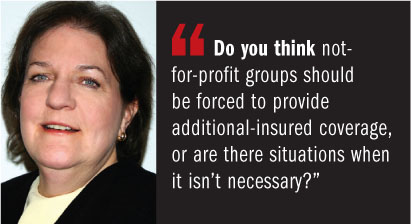One of the most common policy-endorsement requests is to add an additional insured to a commercial general liability (CGL) policy. Parties who add others as additional insureds are sharing their liability insurance with that other entity and may have to pay an additional premium in order to do so. These endorsements generally promise to defend the additional insured in the event of a claim or suit.
 Typically, the insured that controls the work or the property provides the primary insurance, adding the owner or landlord as an additional insured. For example, tenants add building owners as additional insureds; manufacturers add vendors; and subcontractors add contractors or owners.
Typically, the insured that controls the work or the property provides the primary insurance, adding the owner or landlord as an additional insured. For example, tenants add building owners as additional insureds; manufacturers add vendors; and subcontractors add contractors or owners.
One relationship that may not be as obvious is that of a facility owner that insists on being added as an additional insured on a temporary occupant's CGL policy. This doesn't seem unusual when a seasonal or holiday retail outlet sets up a kiosk or temporary sales site in a mall.
Recommended For You
Want to continue reading?
Become a Free PropertyCasualty360 Digital Reader
Your access to unlimited PropertyCasualty360 content isn’t changing.
Once you are an ALM digital member, you’ll receive:
- Breaking insurance news and analysis, on-site and via our newsletters and custom alerts
- Weekly Insurance Speak podcast featuring exclusive interviews with industry leaders
- Educational webcasts, white papers, and ebooks from industry thought leaders
- Critical converage of the employee benefits and financial advisory markets on our other ALM sites, BenefitsPRO and ThinkAdvisor
Already have an account? Sign In Now
© 2025 ALM Global, LLC, All Rights Reserved. Request academic re-use from www.copyright.com. All other uses, submit a request to asset-and-logo-licensing@alm.com. For more information visit Asset & Logo Licensing.








